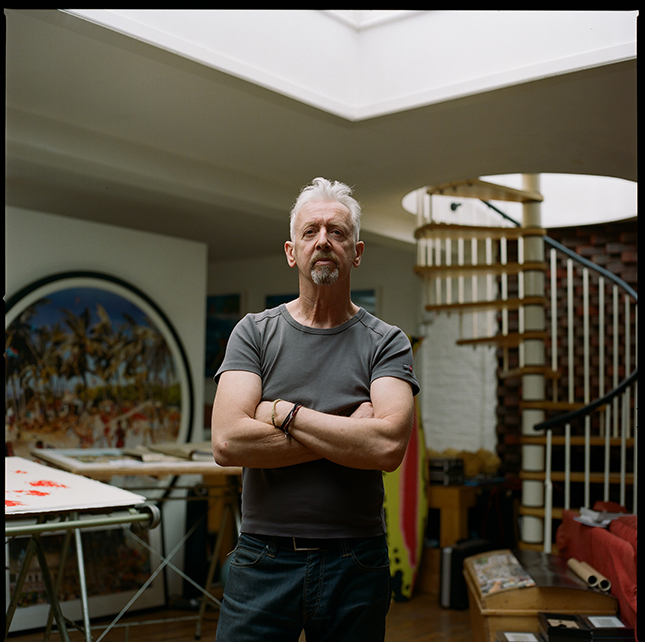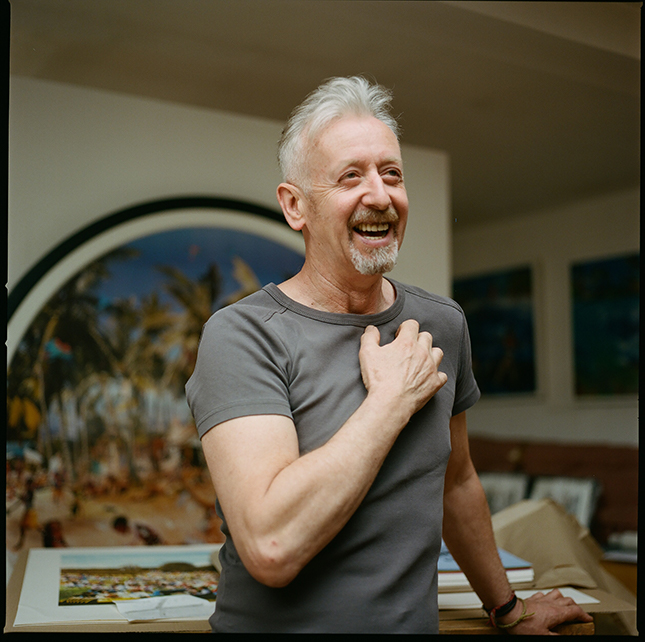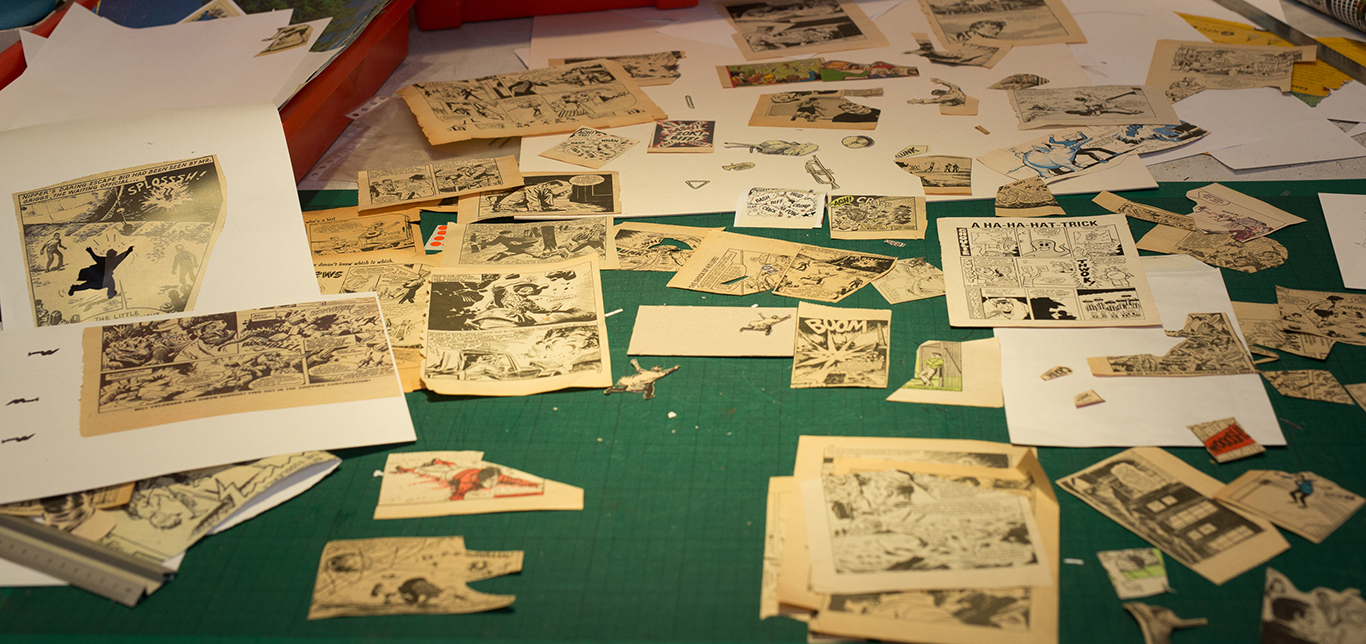MAKING OUR NEWS INTO ART
An interview with sculptor David Mach about his career, education and the materials he chooses to use in his artwork
We meet David Mach in his South London studio on a sunny afternoon a few days after he completed his momentous installation ‘Incoming’ at Griffin Gallery. Despite how strenuous the installation was to install for David and his team, when we meet he is still working – this time on a series of collages to exhibit alongside his installation at Griffin Gallery. While he was working we talked to him about his career, education and the materials he chooses to use in his artwork.

Colart: Tell us about your education – did you study art?
David: I was 18 when I went to art college. I loved it from the word go, but I was pushed into it. I did make artwork at school though, looking back I see that I did do a lot of things, and I was involved in a lot of things that actually were really important for my career, right from when I was a tiny kid all the way through, you just don’t know that they’re artistic, it hits you later on. I’m still doing things that I was doing when I was 6 years old, which is slightly ridiculous. You carry these things with you, and it will either be a positive or a negative, it could be beaten out of you before you get a chance to explore it. All you need is courage to explore your ideas.
Colart: It sounds like you’ve always been attracted to making, whether you realised it was artistic or not.
David: I grew up in Fife, south Scotland – it was a fantastic playground, and I was so lucky with that. The industry and the countryside meant that I had a fantastic array of materials to use, and I was always seeing this huge machinery. I used strange things but now I realise you’re driven to do that by how you’re made. I learned what materials I could use, what was too heavy for me to lift. But our industry in that sense is almost completely gone.
Colart: Was it unusual for you to have gone to art school?
David: I was the first in the family to go into any further education, so that was unusual first of all. But it doesn’t feel right to say it was unusual because it seemed like an incredibly creative place, and an incredibly creative time, despite being working class and industrial. It certainly wasn’t brave for me to go to art school.
The best thing about it was how cheap it was – I could have all the space I needed. I had two studios. Once I bought the Oxfam shop out – the whole shop – for a fiver. I got a van, took it all up to the studio and started playing with it; I think I had about 15 wardrobes. It was an incredible space to have that freedom.
At art college you’re being nurtured and helped, and for some reason I found that really kind of difficult. I had to find a place where it wasn’t quite so friendly – I tried to work outside of the art college where my work would get more of a reaction.
Colart: Did you leave art college knowing what you wanted to make?
David: I had started making large scale work before I left, but then I went to the Royal College in London. I did 8 years straight, so I was virtually institutionalised, and I was very nervous for a couple of years. I was also very lucky, because I started showing immediately. But that made me even more nervous because I felt like I was trying to fit into a system again. A lot of people get steered in a direction that they don’t want to go in, but I was stubborn. If I wasn’t happy I didn’t do it.
Colart: Your installations are usually extremely large in scale – how much do you rely on teamwork to create your artwork?
David: Friends helped me at art college, and when I was a child I was always the team leader, telling my friends to help me lift rocks or logs. But what’s great is to harness the energy of a group of people to create an artwork. With teamwork it was easy to get the jeep for ‘Incoming’ into the gallery, and people enjoyed doing it. You’re drawn into the thing. It’s like a car stuck in the mud. I especially like that kind of stuff, when people are going ‘we’ll never do this’; ‘we’ll never do that’. But installing ‘Incoming’ felt easy. You’re knackered by it – it’s physically demanding – but it’s not impossible.
Colart: Are the type of materials you use important? For example, why do you use newspapers rather than magazines?
David: It has an influence – but really it’s about the colour. Some magazines have coloured edges, but you’ll hardly get that with newspapers. The great thing about the Financial Times is you get that kind of pink thing going on. So you want a little bit of that, but really I see it as the detritus, the muck and the mush of life. These newspapers feed off negativity so generally, I find myself repelled by them. I’m more interested in the fact that they’re supposed to be interesting and provide you with information and lead you somewhere in the world.

Colart: Is it important for you to use recycled materials?
David: It’s just the stuff of life. There’s an awful lot of stuff in the world, and everything is going to get thrown away. I want to use stuff that connects me to you, I don’t want to be separate in any shape of form, I want to be connected. So that I’m not this rare thing, living in a rare place, allowed to be rare whilst everyone else lives a normal life. And this definitely comes from growing up in Fife. The art world is a very odd place for me to inhabit sometimes, because it is rarefied. I’m one of those people who always feels like they’re about to be tapped on the shoulder and asked to leave the party, but that’s a great position to be in, because the best thing you can be in life is an infiltrator.
Colart: When installing your large scale installations you often have an audience – do you think it’s important for the viewer to see how the artwork is made and do your interactions with an audience influence your work?
David: When I’m making these things I get asked questions all the time, some of them not very smart, and some that really put you on the spot. It’s important for people to see the sheer effort that goes into making the work. When you tell people you’re going to make a work of art and it’s going to be made from 20 tonnes of magazines, a tractor, and a hundred pallets they all think you’re mad – and that’s usually what’s written on their faces when I start. People want to see you making art with paint or making sculptures out of marble, but that’s just one kind of art and this is another. But I like that – I’ve been so many places where the audience re-evaluates their opinion after seeing the weeks of sheer effort that goes into making the thing, because they’ve been given the space to think about it.
Colart: Did you ever use traditional materials?
David: I tried stone carving, they gave me little hammer and chisel, but I’d just end up with a pile of rubble. I got a brilliant traditional training – modelling from life, drawing from life which was all really important. I find painting is like digging holes. I paint with collage. Collage will teach you everything. I like the idea of finding things. The words and the people in my collages have existed already, I didn’t make them, I didn’t draw them, I didn’t design them; but I’ve pulled them all back into this other place – and it makes you think about things twice. Don’t take it all for granted. Some of it really is pretty ironic and funny – but they are alternative facts, it’s fake news.
Colart: What inspires you?
David: Like most artists I suffer from that curse of being terribly serious. I live, eat, breathe and smoke this stuff, otherwise it’s not worth doing. I’m guilty of not being a great art lover. I don’t visit exhibitions if I can help it. I’m not under stimulated.
‘Incoming’ by David Mach is open at Griffin Gallery until 7 July. To find out more please visit the Griffin Gallery website.
